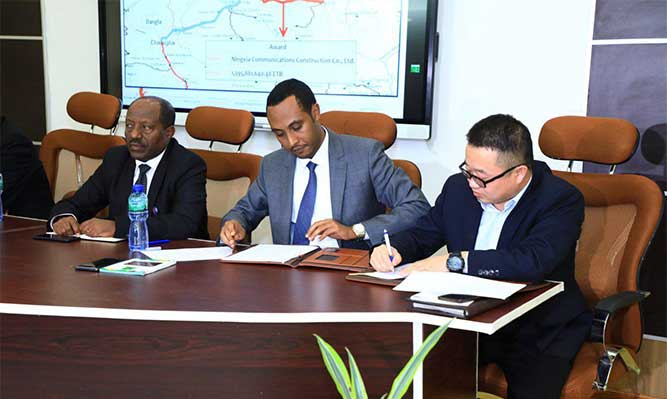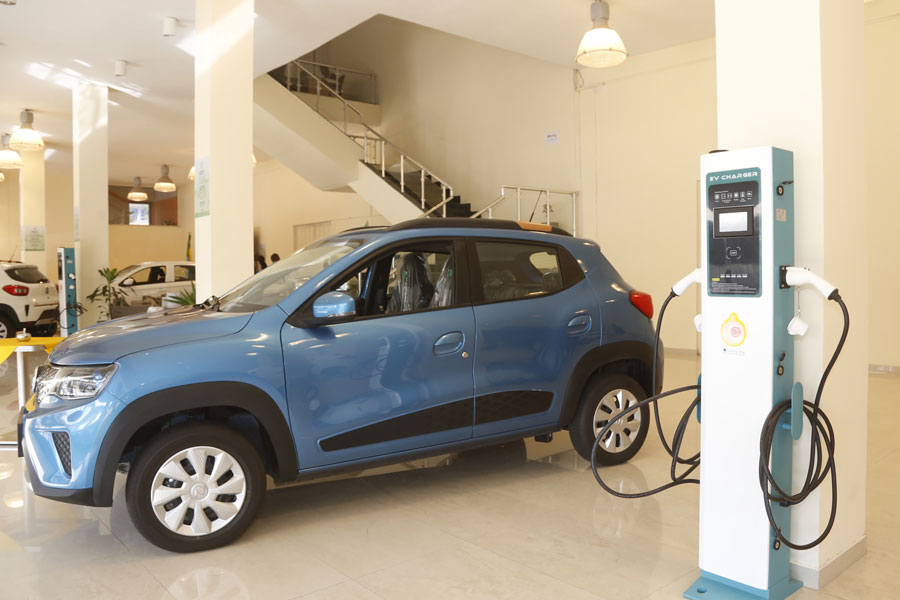
Fortune News | Dec 07,2019
Robel Adanne, a third-year biology student at Addis Abeba University College of Natural Sciences, lives around Meri Loqe in Yeka district about 12 Km from his campus.
To reach his campus, he has to leave his home two hours early to arrive on time for his 8:30am class.
His travels from his neighborhood to Megenagna roundabout is very congested during rush hours and any 10 or 15 minute delay on his part will mean spending more time on the congested roads and arriving to school 30 or 40 minutes late.
This is experienced by nearly all commuters who use Asmara Road to travel from their homes in the suburbs of Addis Abeba to the commercial and business centers of the capital.
During peak hours, upward of 5,000 cars pass through the Ayat-Megenagna artery in an hour, according to a survey conducted in 2017 by the City’s Traffic Management Agency.
Recognising the problem, the Addis Abeba City Traffic Management Agency launched a pilot project to stem the congestion along the corridor.
The project aims to apportion a traffic lane for a counterflow scheme, the reversal of lanes to temporarily increase the capacity of a given congested road. The scheme allows traffic to flow in the opposite direction on selected lanes during rush hour, hence giving rise to the term ‘counterflow’.
The lanes are typically sectioned off by plastic cones placed at regular intervals, and the flow of traffic is directed in the opposite direction depending on morning and evening rush hours.
The Ayat-Megenagna corridor was selected as it is one of the most congested roads in the city during peak morning and evening travel times, according to Ashu Sintayehu, deputy director of the Agency.
“The fact that Kotebe Road is under construction has increased the pressure on this road,” he added. He is referring to an alternative route that is still under construction just to the north.
A new road system near Salete Mariam on Ayat Road.
In the morning, the main traffic flow is from Ayat, a major residential area in the capital to Megenagna and other commercial and business hubs in Addis Abeba..
Ordered by Deputy Mayor Takele Uma to come up with a solution to the congestion problem, the Agency devised the counterflow scheme that it hopes will go a long way in addressing the problem, according to the deputy director.
“This prompted us to try and use one lane from the relatively free side to relieve the traffic load from the busier side,” Ashu told Fortune.
The new scheme has shown some improvements, according to taxi drivers in the area.
Tsegazeab Neway, who had worked as a taxi driver for four years in Meqelle, has been using the road since his arrival in the capital about 18 months ago. He said that he usually arrives at Megenagna around 7:00am in the morning and starts taking passengers to Ayat around 7:15am.
"It used to take me more than an hour and 45 minutes to make the round trip,” he told Fortune. He claims that time has been cut by more than 30 minutes since the launch of the scheme.
“I have witnessed a general improvement in traffic congestion on this road,” said Tsegazeab.
A formal evaluation of the results of the program is still pending, and a team tasked with surveying the traffic condition has been established. Meanwhile, the Agency has made an informal assessment that the scheme has made a difference.
Before the program was implemented a typical drive from Ayat to Megenagna took 45 minutes during peak hours, which has now been reduced to 27 minutes, according to Ashu.
The Agency has sampled data from regular users of the road, including bus drivers, to make its assessments.
“We chose buses because we wanted to see what the worst case scenario looks like, as buses are very slow in moving through traffic,” explained Ashu.
The counter flow solution is very practical, but it requires increased manpower and budget to effectively implement, regulate and operate it, according to Ashu.
During the first weeks of implementation there was a heavy traffic police presence on the route, but as the weeks passed by that presence has been reduced.
“Now that people are familiar with the system, not as many officers are needed,” explained Major Sergeant Getahun Duwalla.
He has been assigned to the corridor prior to the implementation of the program and attested that he has witnessed the difference.
“Although I can’t quantify it, the feedback we get from the public is positive,” he added.
Engida Tadie, a lecturer at Kotebe Metropolitan University, Department of Urban Transportation Development, also commends the Agency’s effort to create some relief through unconventional solutions.
“If the drivers in Addis were disciplined, they could have even given two lanes for the counter flow traffic,” said Engida.
As a permanent solution, Engida recommends that the Agency work on encouraging the public to use mass transportation. He urges that the city establishes dedicated lanes for buses.
Traffic management and road management officials need to work together so that the capacity of the road can match the number of residents in an area,” recommends Engida.
Though the new project keeps the flow smooth and without accidents, it has created some inconvenience for cars coming out of the side roads in the neighborhoods to join the main road. These cars are now obliged to travel in the opposite direction of their normal flow on the new counter flow lanes and seek openings where they can make U-turns, which is creating traffic hazards.
“These cars cut across three lanes to make U-turns to return to the opposite traffic. This can lead to accidents if they are not careful," said Getahun.
It has been over three months since Robel arrived to class late.
“Now, I can leave from home 30 minutes later than usual and still arrive on time to campus,” said Robel.
“I have doubts as to how long this solution will work, because the number of cars will only increase as more and more people move into this residential area.”
Official figures estimate that there are over 800,000 vehicles in the capital, of which 90pc are imported. During the last fiscal year, Ethiopia spent 544.3 million dollars to import vehicles.
During the first nine months of the last fiscal year, Addis Abeba, which has a road coverage of 22pc, witnessed 325 fatalities, and 1,441 major and 673 minor injuries.
Observing the efficiency of the new scheme, the Agency is planning to implement the program elsewhere and is working to fulfill the necessary resource before launching it.
“We need more skilled professionals in the transportation sector so that we start to address the problems more scientifically,” Ashu said.
Engida also believes that alleviating the traffic congestion on major roads of the city could be beyond the responsibility of the Agency. Organisations should also take the assignment, according to him.
"Organisations and businesses can vary working hours of their employees to avoid rush hours," he said.
PUBLISHED ON
Mar 02,2019 [ VOL
19 , NO
983]

Fortune News | Dec 07,2019

Radar | Oct 31,2020

Viewpoints | May 03,2025

Verbatim | Nov 21,2020

Radar | Jun 18,2022

Radar | Oct 12,2019

Commentaries | Sep 04,2021

Agenda | Mar 30,2024

Sunday with Eden | May 27,2023

Radar | Jan 23,2021

Dec 22 , 2024 . By TIZITA SHEWAFERAW
Charged with transforming colossal state-owned enterprises into modern and competitiv...

Aug 18 , 2024 . By AKSAH ITALO
Although predictable Yonas Zerihun's job in the ride-hailing service is not immune to...

Jul 28 , 2024 . By TIZITA SHEWAFERAW
Unhabitual, perhaps too many, Samuel Gebreyohannes, 38, used to occasionally enjoy a couple of beers at breakfast. However, he recently swit...

Jul 13 , 2024 . By AKSAH ITALO
Investors who rely on tractors, trucks, and field vehicles for commuting, transporting commodities, and f...

Nov 1 , 2025
The National Bank of Ethiopia (NBE) issued a statement two weeks ago that appeared to...

Oct 25 , 2025
The regulatory machinery is on overdrive. In only two years, no fewer than 35 new pro...

Oct 18 , 2025
The political establishment, notably the ruling party and its top brass, has become p...

Oct 11 , 2025
Ladislas Farago, a roving Associated Press (AP) correspondent, arrived in Ethiopia in...